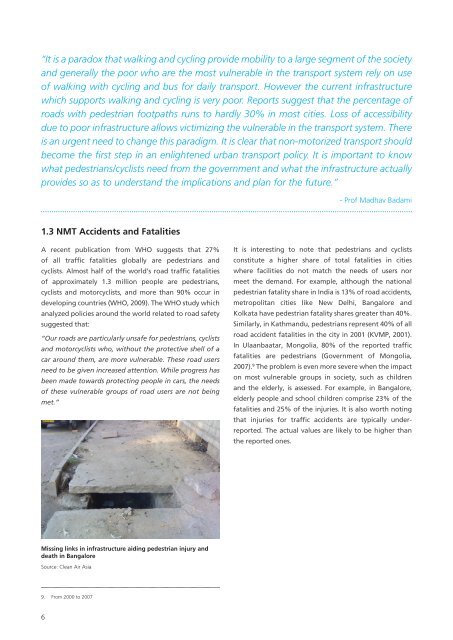Promoting Non-motorised Transport in Asian Cities
Shakti Sustainable Energy Foundation conducted a study to assess the viability of promoting non-motorised transport in Asian cities. As part of the study, they undertook a project – Nehru Place Placemaking. See more at: http://shaktifoundation.in/report/promoting-non-motorised-transport-asian-cities-policymakers-toolbox/
Shakti Sustainable Energy Foundation conducted a study to assess the viability of promoting non-motorised transport in Asian cities. As part of the study, they undertook a project – Nehru Place Placemaking. See more at: http://shaktifoundation.in/report/promoting-non-motorised-transport-asian-cities-policymakers-toolbox/
Create successful ePaper yourself
Turn your PDF publications into a flip-book with our unique Google optimized e-Paper software.
“It is a paradox that walk<strong>in</strong>g and cycl<strong>in</strong>g provide mobility to a large segment of the society<br />
and generally the poor who are the most vulnerable <strong>in</strong> the transport system rely on use<br />
of walk<strong>in</strong>g with cycl<strong>in</strong>g and bus for daily transport. However the current <strong>in</strong>frastructure<br />
which supports walk<strong>in</strong>g and cycl<strong>in</strong>g is very poor. Reports suggest that the percentage of<br />
roads with pedestrian footpaths runs to hardly 30% <strong>in</strong> most cities. Loss of accessibility<br />
due to poor <strong>in</strong>frastructure allows victimiz<strong>in</strong>g the vulnerable <strong>in</strong> the transport system. There<br />
is an urgent need to change this paradigm. It is clear that non-motorized transport should<br />
become the first step <strong>in</strong> an enlightened urban transport policy. It is important to know<br />
what pedestrians/cyclists need from the government and what the <strong>in</strong>frastructure actually<br />
provides so as to understand the implications and plan for the future.”<br />
- Prof Madhav Badami<br />
1.3 NMT Accidents and Fatalities<br />
A recent publication from WHO suggests that 27%<br />
of all traffic fatalities globally are pedestrians and<br />
cyclists. Almost half of the world’s road traffic fatalities<br />
of approximately 1.3 million people are pedestrians,<br />
cyclists and motorcyclists, and more than 90% occur <strong>in</strong><br />
develop<strong>in</strong>g countries (WHO, 2009). The WHO study which<br />
analyzed policies around the world related to road safety<br />
suggested that:<br />
“Our roads are particularly unsafe for pedestrians, cyclists<br />
and motorcyclists who, without the protective shell of a<br />
car around them, are more vulnerable. These road users<br />
need to be given <strong>in</strong>creased attention. While progress has<br />
been made towards protect<strong>in</strong>g people <strong>in</strong> cars, the needs<br />
of these vulnerable groups of road users are not be<strong>in</strong>g<br />
met.”<br />
It is <strong>in</strong>terest<strong>in</strong>g to note that pedestrians and cyclists<br />
constitute a higher share of total fatalities <strong>in</strong> cities<br />
where facilities do not match the needs of users nor<br />
meet the demand. For example, although the national<br />
pedestrian fatality share <strong>in</strong> India is 13% of road accidents,<br />
metropolitan cities like New Delhi, Bangalore and<br />
Kolkata have pedestrian fatality shares greater than 40%.<br />
Similarly, <strong>in</strong> Kathmandu, pedestrians represent 40% of all<br />
road accident fatalities <strong>in</strong> the city <strong>in</strong> 2001 (KVMP, 2001).<br />
In Ulaanbaatar, Mongolia, 80% of the reported traffic<br />
fatalities are pedestrians (Government of Mongolia,<br />
2007). 9 The problem is even more severe when the impact<br />
on most vulnerable groups <strong>in</strong> society, such as children<br />
and the elderly, is assessed. For example, <strong>in</strong> Bangalore,<br />
elderly people and school children comprise 23% of the<br />
fatalities and 25% of the <strong>in</strong>juries. It is also worth not<strong>in</strong>g<br />
that <strong>in</strong>juries for traffic accidents are typically underreported.<br />
The actual values are likely to be higher than<br />
the reported ones.<br />
Miss<strong>in</strong>g l<strong>in</strong>ks <strong>in</strong> <strong>in</strong>frastructure aid<strong>in</strong>g pedestrian <strong>in</strong>jury and<br />
death <strong>in</strong> Bangalore<br />
Source: Clean Air Asia<br />
9. From 2000 to 2007<br />
6

















